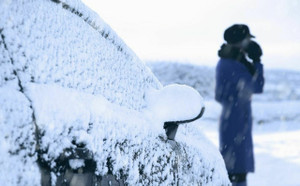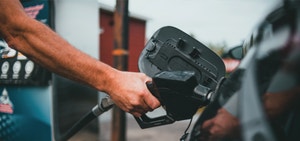What should you have in your car in case of an emergency?
By Kijiji Autos
Most of us—myself included—don't have everything we might need in our vehicles in case of an emergency.
Of course, it’s unlikely you’ll use every item in this article, but what you don’t use could end up helping another driver.
Here’s a list of practical—and in some cases essential—items to have in your vehicle in case of an emergency.
Food and water
You should always carry some emergency food provisions in your vehicle. However, make sure you choose simple items that have a long shelf life. Granola or energy bars, nuts or canned foods are your best options. Don’t forget that if you do need them, you’ll probably be eating them cold, since a microwave oven isn’t part of this list. If you decide to include canned foods, be sure to add a can opener to your kit. A few bottles of water, preferably in plastic bottles, are also a must. I recommend you bring water each time you drive, in addition to the water in your emergency kit, especially in winter, when the water in your kit may be frozen.
Blankets, clothing and shoes
It’s one thing when a car breaks down in summer, but it’s a completely different problem on a cold winter’s day. It’s a good idea to carry one or more blankets in case you’re stuck or your car won’t start in cold weather. If the passenger compartment turns cold, a blanket and a few extra pieces of clothing will help you stay warm, and an extra pair of shoes or boots will come in handy if your feet get wet.
First aid kit
If you do nothing else, put a first aid kit in your car. There are all kinds of kits to choose from, and their contents may vary. Try to find one that’s as complete as possible, and don’t forget to check the expiry date on any ointments in the kit. Also, add scissors that aren’t just intended to cut bandages but that are strong enough to cut through clothing and even a seatbelt, as extreme as that sounds. Another practical addition is a whistle. This may seem odd at first, but if you need to attract someone’s attention, a whistle is a lot better than yelling at the top of your lungs.
Shovel, ice scraper, snow brush, antifreeze, and washer fluid
I don’t have to remind Canadians to put an ice scraper and snow brush in their car in winter. A shovel may not be automatic, but it can become your best friend if you’re stuck in a snowbank. There are many shovel models on the market with retractable handles for easy storage in a car. Be careful about storing antifreeze, however, especially if you have pets or are driving in rural areas. Antifreeze has a sweet odour and taste that attracts animals, so be sure to store it where they can’t get at it. It can be poisonous if ingested.
Candles, matches and a flashlight
In winter, candles can come very handy. Not only will they provide a little light if it’s dark out, but can even help heat the passenger compartment of the car. If you buy bucket candles like the one in the photo, you won’t have to worry about wax dripping onto the car’s interior. You’ll also need matches to light your candles. I’m aware that lighters exist, but matches are more reliable and don’t require lighter fuel. A flashlight is also very useful in case of an emergency at night and will help you find other things in your kit. It’s preferable to buy a hand-crank flashlight rather than one that’s battery-powered. If you go the battery-powered route, don’t forget you’ll also need spare batteries.
Sand, salt, cat litter, booster cables and flares
Sometimes we just need a little help to get out of trouble. Sand, salt or even cat litter can be very practical in giving you that bit of extra traction to set your vehicle free. If you decide on cat litter, choose the non-clumping kind. Booster cables can also be of service in starting your vehicle if the battery runs low. Plan on adding a few flares as well so that you can secure the area around your car once you’ve pulled off to the side of the road. This way, other drivers will get an early warning and use more caution when they pass you.
Tire repair kit and portable compressor
Flat tires happen to us all. If your car has one, you’ll be glad you took some precautionary steps. A tire repair kit will enable you to fix a flat and drive to the nearest garage. With a portable compressor you can add air to a tire that’s flat or partially deflated. Even with a puncture, you may be able to inflate the tire enough to get to a service station. Also keep in mind that most new cars no longer come with a spare tire, just an emergency repair kit. If you have a late model vehicle, check the trunk to see what you have.
If you carry the items listed in this article, you’ll be ready for just about anything. You’ll probably increase your fuel consumption by 1 litre/100 kilometres or so, but it’ll be worth it. In all likelihood, you won’t need all of these things for your day-to-day driving. But if you’re planning a longer trip, heading somewhere you’ve never been, or don’t have access to roadside assistance, these items may prove extremely useful. It’s simply a case of being proactive.
Safe travels!
Easily find your next ride on Kijiji Autos
Search nowHow Long Can a Car Sit Unused?
How long can a car be left without starting it? Keep reading to explore everything you need to know about unused cars.Costs of Installing an Electric Car (EV) Charging Station in Canada
Installing a home EV charger can come with additional fees beyond purchase and installation. Here's a list of factors that can affect the price of a home EV charger.Toronto to Calgary Road Trip: Routes & Tips
Planning on driving from Toronto to Calgary? Here are some routes and tips to help you along the way.Flat Tire vs Blowout: What's the Difference & What Should You Do?
The main difference between a flat tire and a blowout is that a blowout often feels like an explosion has occurred underneath your vehicle. Blowouts can cause sudden and drastic changes to the handling of your vehicle and can lead to minor or even serious accidents.7 items you can fit in an SUV: TVs, mattresses and more
Discover seven common items that fit in an SUV below.Tips to help protect your vehicle and budget for car repairs
When shopping for your next vehicle, it's always a good idea to keep hidden costs in mind. Before you buy, let's look at how much it can cost to maintain a car in Canada, how much you could budget for annual maintenance and repairs, and how to help protect your car against damage and depreciationThe top three best paint protection options for your vehicle
Buying a new vehicle is a great experience. Nothing beats hitting the road in a car you bought fresh off the lot. However, as fun as it is to finally get behind the wheel of your new ride, it's important to take your time through the process.What is the value of undercoat protection on your vehicle?
When you buy a new vehicle, protecting it so that it lasts as long as possible is definitely top of mind, whether that's through security upgrades or an extra coat of paint. But how often do you consider the care and safety of your vehicle’s undercarriage?Financial guide: post-pandemic car shopping and gas price hacks
With populations locked down and international borders closed the global supply chain has been disrupted on a massive scale, pushing up inflation around the world and raising the cost of everything that people need to get back to normal. Here are a few tips you can use to grab the vehicle you want without breaking the bank.10 tips to help make the road a better and happier place
We have all, at some point, been responsible for making the roadways stressful in one way or another. Alternatively, we are all equally capable of making the road a happier place. Let’s explore 10 unique ways we can help make the driving experience better again, for everyone's sake.








